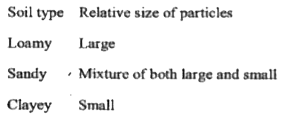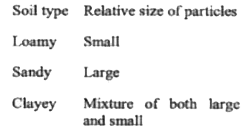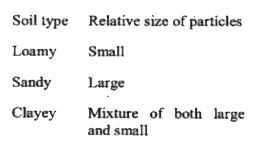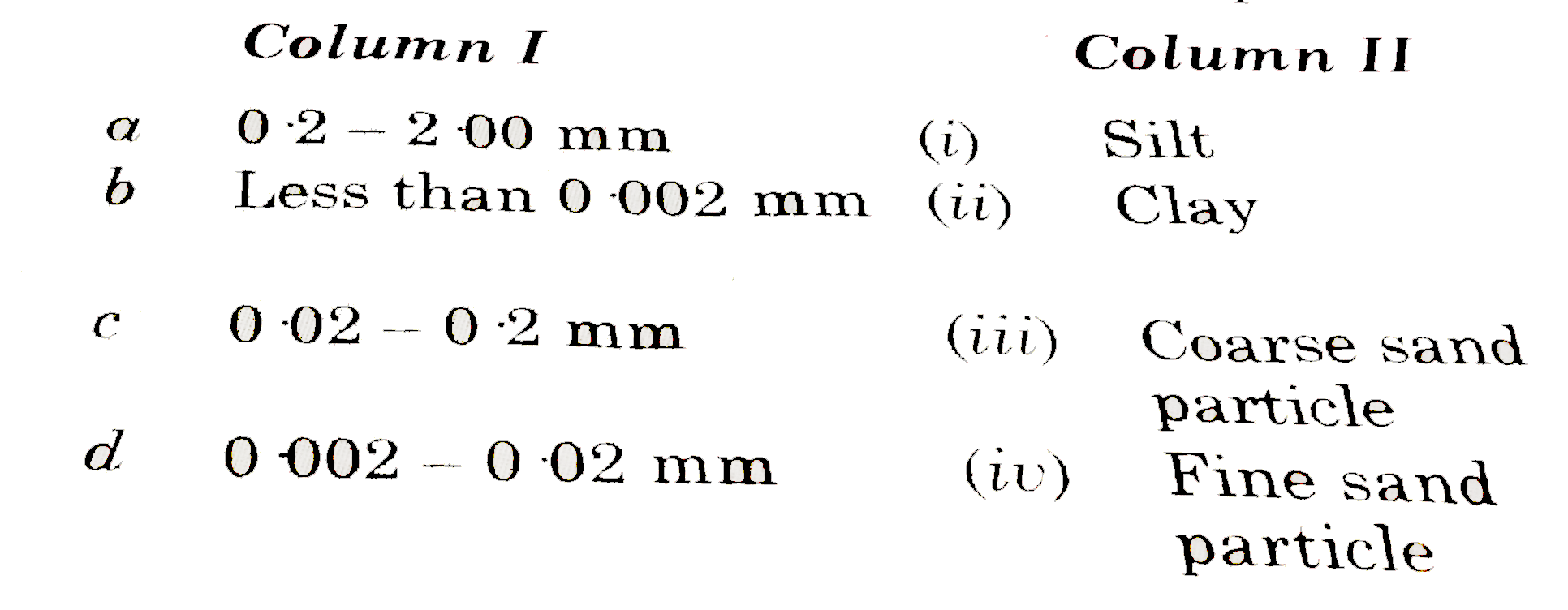Soils are classified as sandy, loamy or clayey depending on the relative size of the particles. Which of the following tables correctly matches the soil type with its relative particle size?




To solve the question about the classification of soils based on the relative size of their particles, we can follow these steps:
1. Understand Soil Types:
- There are three main types of soil: sandy, loamy, and clayey.
- Each type is characterized by the size of its particles.
2. Identify Particle Sizes:
- Sandy Soil: This type has large particles. It allows water to drain quickly and has good aeration.
- Clayey Soil: This type has small particles. It retains water well but has poor drainage and aeration.
- Loamy Soil: This is a mixture of sand, silt, clay, and humus. It has a balanced particle size, combining features of both sandy and clayey soils.
3. Create a Table for Comparison:
- We can summarize the information in a table format:
| Soil Type | Relative Particle Size |
|-----------|------------------------|
| Sandy | Large |
| Loamy | Medium (mixed) |
| Clayey | Small |
4. Match the Options:
- Based on the table, we need to find the option that correctly matches the soil type with its relative particle size.
- The correct match is:
- Sandy: Large
- Loamy: Medium
- Clayey: Small
5. Select the Correct Option:
- After reviewing the options provided in the question, we determine that the option that corresponds to the table we created is the correct answer.
Final Answer:
The correct option that matches the soil type with its relative particle size is Option 3.
---
- There are three main types of soil: sandy, loamy, and clayey.
- Each type is characterized by the size of its particles.
- Sandy Soil: This type has large particles. It allows water to drain quickly and has good aeration.
- Clayey Soil: This type has small particles. It retains water well but has poor drainage and aeration.
- Loamy Soil: This is a mixture of sand, silt, clay, and humus. It has a balanced particle size, combining features of both sandy and clayey soils.
- We can summarize the information in a table format:
|-----------|------------------------|
| Sandy | Large |
| Loamy | Medium (mixed) |
| Clayey | Small |
- Based on the table, we need to find the option that correctly matches the soil type with its relative particle size.
- The correct match is:
- Sandy: Large
- Loamy: Medium
- Clayey: Small
- After reviewing the options provided in the question, we determine that the option that corresponds to the table we created is the correct answer.
The correct option that matches the soil type with its relative particle size is Option 3.
Topper's Solved these Questions
- SOILBook:BETOPPERSChapter:SOILExercise:SUMMATIVE WORKSHEET (MULTIPLE CHOICE QUESTION)
Explore 5 Videos
- SOILBook:BETOPPERSChapter:SOILExercise:SUMMATIVE WORKSHEET (TRUE OR FALSE)
Explore 8 Videos
- SOILBook:BETOPPERSChapter:SOILExercise:SUMMATIVE WORKSHEET
Explore 14 Videos
- OUR ENVIRONMENTBook:BETOPPERSChapter:OUR ENVIRONMENTExercise:SUMMATIVE WORKSHEET (ANSWER THE FOLLOWING QUESTIONS:)
Explore 24 Videos
- STRUCTURE AND FUNCTIONS OF PLANT PARTSBook:BETOPPERSChapter:STRUCTURE AND FUNCTIONS OF PLANT PARTSExercise:SUMMATIVE WORKSHEET (ODD ONE OUT)
Explore 5 Videos
Similar Questions
Knowledge Check
Which of the following matched pair correctly depicts a stipule type and its example
Aspinous - similaxBtendrillar - acaciaCochraceate - polygonumDadnate - pisumWhich of the following has smallest of soil particles?
ALoam soilBSandCClayDSilt.A colloidal system has particles of which of the following size ?
A10−9mto10−12mB10−6mto10−9mC10−4mto10−10mD10−5mto10−7m
Match the columns of size with soil particles

View SolutionWhich order of relative size amongst the following is incorrect ?
View SolutionWhich order of relative size amongst the following is incorrec ?
View SolutionAmino acids are classified as acidic, basic or neutral depending upon the relative number of amino and carboxyl groups in their molecule. Which of the following are acidic?
View SolutionAmino acids are classified as acidic, basic or neutral depending upon the relative number of amino and carboxyl groups in their molecule. Which of the following are acidic?
View Solution
